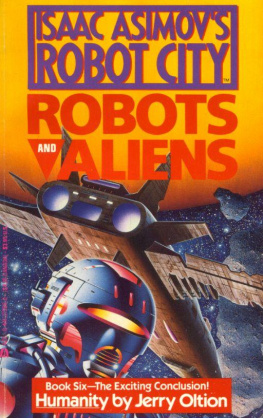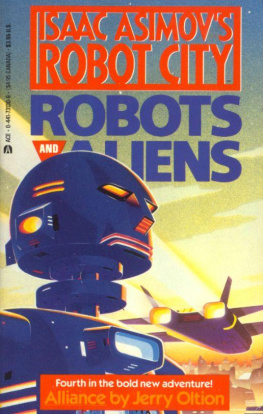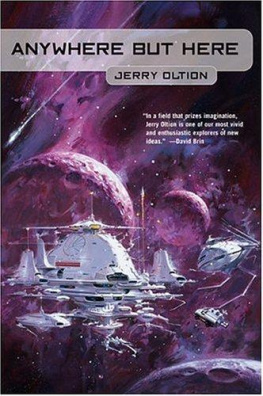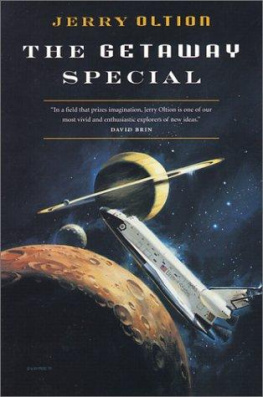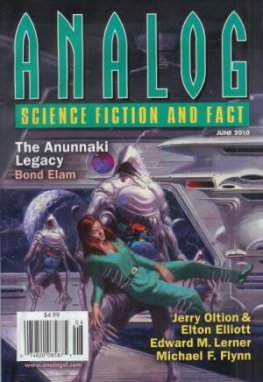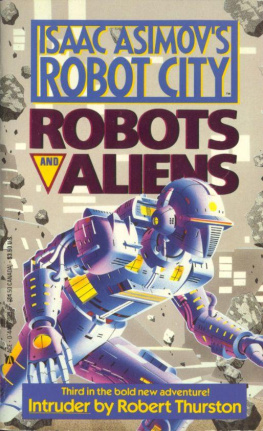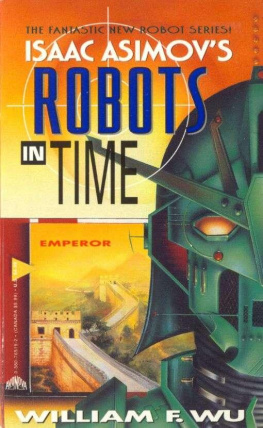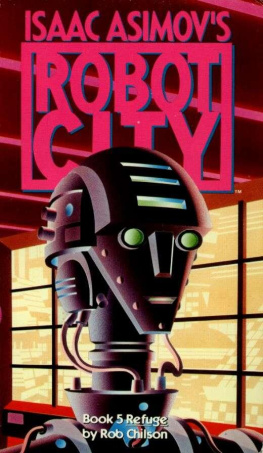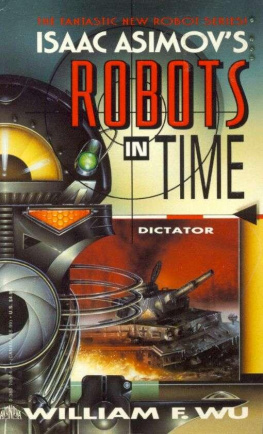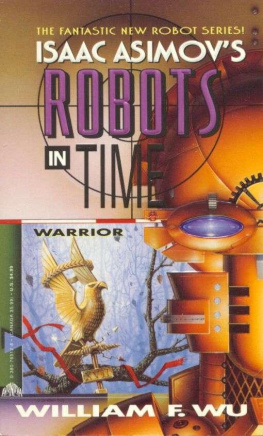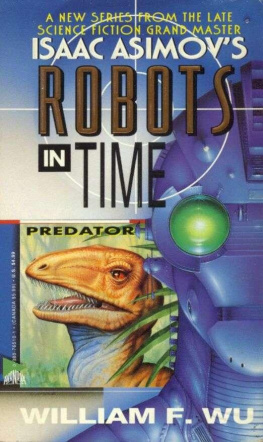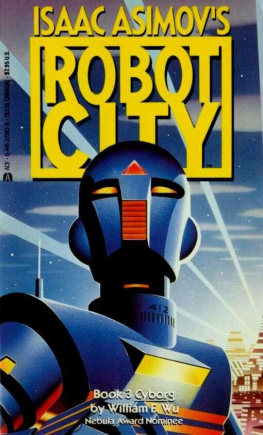Jerry Oltion - Humanity (Isaac Asimovs Robot City : Robots and Aliens, Book 6)
Here you can read online Jerry Oltion - Humanity (Isaac Asimovs Robot City : Robots and Aliens, Book 6) full text of the book (entire story) in english for free. Download pdf and epub, get meaning, cover and reviews about this ebook. year: 1990, publisher: Ace, genre: History. Description of the work, (preface) as well as reviews are available. Best literature library LitArk.com created for fans of good reading and offers a wide selection of genres:
Romance novel
Science fiction
Adventure
Detective
Science
History
Home and family
Prose
Art
Politics
Computer
Non-fiction
Religion
Business
Children
Humor
Choose a favorite category and find really read worthwhile books. Enjoy immersion in the world of imagination, feel the emotions of the characters or learn something new for yourself, make an fascinating discovery.
- Book:Humanity (Isaac Asimovs Robot City : Robots and Aliens, Book 6)
- Author:
- Publisher:Ace
- Genre:
- Year:1990
- Rating:5 / 5
- Favourites:Add to favourites
- Your mark:
- 100
- 1
- 2
- 3
- 4
- 5
Humanity (Isaac Asimovs Robot City : Robots and Aliens, Book 6): summary, description and annotation
We offer to read an annotation, description, summary or preface (depends on what the author of the book "Humanity (Isaac Asimovs Robot City : Robots and Aliens, Book 6)" wrote himself). If you haven't found the necessary information about the book — write in the comments, we will try to find it.
Humanity (Isaac Asimovs Robot City : Robots and Aliens, Book 6) — read online for free the complete book (whole text) full work
Below is the text of the book, divided by pages. System saving the place of the last page read, allows you to conveniently read the book "Humanity (Isaac Asimovs Robot City : Robots and Aliens, Book 6)" online for free, without having to search again every time where you left off. Put a bookmark, and you can go to the page where you finished reading at any time.
Font size:
Interval:
Bookmark:
ISAAC ASIMOVS
ROBOT CITY
ROBOTS AND ALIENS
Book 6
Humanityby Jerry Oltion
Copyright 1990
ROBOTS AND EVOLUTION
BY ISAAC ASIMOV
In general, there are two types of change that take place in the Universe: catastrophic and evolutionary.
A catastrophic change is characterized by a large alteration of conditions in a short period of time. An evolutionary change is characterized by slow alterations of conditions over a long period of time.
Clearly, catastrophic change is more dramatic, but if we observe the Universe around us, it is equally clear that evolutionary change is the rule.
A star shines for anywhere from many millions to many billions of years, slowly evolving, until it reaches a point where (if it is large enough) there is an overbalancing, so to speak, and, in the space of a few minutes or a few hours, it explodes as a supernova and collapses. Catastrophe! But, thereafter, it exists as a white dwarf, neutron star, or black hole, and returns to prolonged evolutionary change.
Again, a huge cloud of dust and gas slowly circling and condensing undergoes evolutionary change, until its center reaches the level of temperature and pressure where nuclear fusion can begin. There is then ignition and a sun is born. Catastrophe! But, thereafter, a planetary system evolves over the space of a few million years, achieves equilibrium, and continues to evolve over the space of a few billion years.
Still again, a planet like Earth can evolve, geologically, over a period of millions of years, perhaps even billions, undergoing slow changes that result in sea-floor spreading, moving plates and shifting continents, rising and eroding of mountain chains, and so on. There are punctuations in the form of minor catastrophes, an earthquake here, a volcanic eruption there, a sudden flooding yon, but, beyond and between such events, evolutionary change proceeds. There is even, once in a while, the chance of a cometary or asteroidal collision that may bring about a far greater catastrophe, but after that, too, evolutionary change continues.
Catastrophic changes, because they occur at long intervals (the greater the catastrophe, the longer, in general, the intervals), because they are sudden, and because they are often unpredictable, are difficult to study. Evolutionary changes, however, are always at our doorstep, always available for detailed and prolonged study.
Following the line of least resistance, then, let us forget about catastrophein this introduction, at leastand concentrate on evolution.
There are two types of evolution that need concern us. First, there is evolution that is non-directed but takes place only in response to the blind forces of nature. These are governed, we might say, by the generalizations we have observed which we call the laws of nature.
Second, there is directed evolution, changes that take place in response to the guiding needs of some intelligence.
Non-directed evolution is what we generally studythe slow changes that take place in the Universe, in individual stars, in the planet we live on.
Yet, if we consider the daily lives of human beings, surely directed evolution is the more important. Over the four or five million years of hominid evolution, human beings have learned to make stone tools, use fire, develop herding and agriculture, form pottery, invent metallurgical techniques, and guide technology in multifarious directions. Over the last two and a quarter centuries we have industrialized the world, and now we have at our disposal such things as computers and spaceships. In addition, we have developed cultural as well as technological techniquesand have created literature, art, and philosophy.
All this has not been in blind and direct obedience to the laws of nature. We are controlled by those laws, yes, and we have limits set for us by them. Within those laws, however, humanity and its ancestors have made advances directed by their own intelligent responses to the needs of life.
You can see the evolutionary nature of human technology if you imagine a display of all the mechanical devices intended for transportation that have been produced by humanitystarting with the wheeled carts of the Sumerians right down to the rocket ships of today.
If you were to study a vast array of these devices carefully arranged in the direction of increasing complexity and efficiency and allowed to branch off in different directionsland vehicles, water vehicles, air vehicles, those dragged by human beings, those dragged by animals, those powered by wind or water, those powered by engines of various shapeswhat would your conclusions be?
If you were a disembodied intelligence from elsewhere, who did not know those devices were human-made, you might suppose that some non-directed evolutionary process had taken place; that somehow there was an inherent drive in transportation devices that would lead them to fill various technological niches and to do so with increasing specialization and expertise. You would study ancestral forms, and note how aircraft developed from landcraft, for instance, and find intermediate forms. Or if, in some cases, you found no intermediate forms, you would blame it on the incompleteness of the record. You would devise all sorts of technological forces (other than intelligence) that would account for the changes you see.
But then, when you were all finished and had a complete theory of technological evolution, someone might tell you, No, no, you are dealing with directed evolution. All these objects were created by human intelligence. All these changes are the result of human experience learning bit by bit to manufacture devices that more efficiently take care of human needs.
That might make you think that scientists may have misinterpreted the records of biological evolution in the same way. We have a vast array of fossils representing ancient and now-extinct forms of life. We arrange them in such a way as to show a steady change from simpler to more complex forms, from lesser to greater variety, from those less like us to those more like us, and from it all we induce a theory of non-directed biological evolution that involves forces acting in blind response to the laws of nature.
But can we now say that, as in the case of transportation devices, we were fooled? Can we imagine the history of life on Earth to be a case of directed evolution with intelligence (call it God) behind every one of the changes?
No, there is a fundamental difference. In the case of technological evolution, every device, every single device, is human-made. No technological device (of the kind we have had hitherto) can make others like itself. If human beings withheld their hands and brains, therefore, technological evolution would stop at once.
In the case of biological evolution, each device (if we can use the term for a living organism) produces many more or less like itself, and with no sign of any direction from outside. It is the imperfection of the process, the fact that the offspring are not exactly like the parents or like each other, that directs the evolution.
But can undirected evolution become directed under some conditions?Clearly, yes.
Through almost all of Earths history, living things had no choice but to change blindly as a result of random gene mutations, and of slow evolutionary changes in living conditions. Catastrophes sometimes resulted in mass extinctionsalso unavoidable.
It was only with the coming of Homo sapiens sapiens that a brain finally existed that was capable of deliberate interference with evolutionary development. Beginning about ten thousand years ago, human beings began to breed plants and animals in such a way as to emphasize those characteristics they considered most valuable. Grains were developed that yielded more food per acre; animals that produced more meat, or milk, or eggs, or wool; that were larger, stronger, and more docile.
Next pageFont size:
Interval:
Bookmark:
Similar books «Humanity (Isaac Asimovs Robot City : Robots and Aliens, Book 6)»
Look at similar books to Humanity (Isaac Asimovs Robot City : Robots and Aliens, Book 6). We have selected literature similar in name and meaning in the hope of providing readers with more options to find new, interesting, not yet read works.
Discussion, reviews of the book Humanity (Isaac Asimovs Robot City : Robots and Aliens, Book 6) and just readers' own opinions. Leave your comments, write what you think about the work, its meaning or the main characters. Specify what exactly you liked and what you didn't like, and why you think so.

